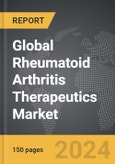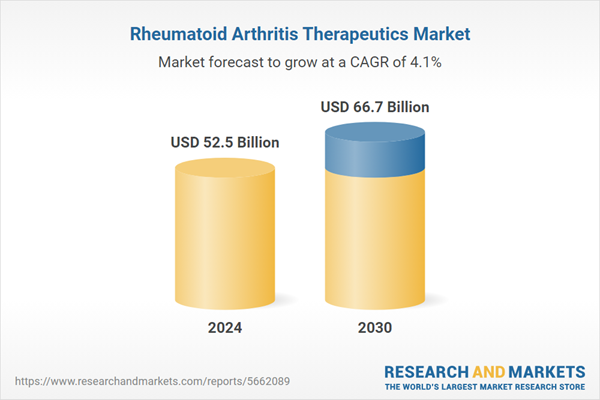Global Rheumatoid Arthritis Therapeutics Market - Key Trends & Drivers Summarized
What Are Rheumatoid Arthritis Therapeutics and How Do They Improve Patient Outcomes?
Rheumatoid arthritis (RA) therapeutics encompass a range of medications designed to manage symptoms and modify the disease process of rheumatoid arthritis, a chronic autoimmune condition characterized by inflammation and pain in the joints. This category includes nonsteroidal anti-inflammatory drugs (NSAIDs), corticosteroids, disease-modifying antirheumatic drugs (DMARDs), and the more recent class of biologics and Janus kinase (JAK) inhibitors, which specifically target inflammatory pathways that contribute to the symptoms and progression of RA. Effective management with these therapeutics can significantly reduce the severity of symptoms, improve physical function, and potentially alter the course of the disease, thus enhancing quality of life for patients.How Is Innovation Shaping Current RA Treatments?
Innovation within RA therapeutics is vigorous, primarily focusing on targeting specific molecular pathways involved in the disease process. The development of biologic DMARDs and JAK inhibitors has revolutionized treatment paradigms. Biologics, such as TNF inhibitors, IL-6 receptor antagonists, and B-cell inhibitors, offer targeted therapy that helps in reducing inflammation and halting disease progression more effectively than traditional treatments. JAK inhibitors, a newer class, have been successful due to their oral administration route and fast-acting nature, providing an alternative for patients who do not respond well to biologic therapies. Moreover, ongoing research in pharmacogenomics aims to personalize RA treatments, maximizing efficacy and minimizing side effects by tailoring medication based on individual genetic backgrounds.What Are the Trends Impacting the RA Therapeutics Sector?
The RA therapeutics market is influenced by several trends. Firstly, an aging global population and rising prevalence of rheumatoid arthritis are increasing demand for effective treatments. The growing patient preference for biologics and JAK inhibitors is shaping the development focus of pharmaceutical companies, steering innovation towards these advanced drug classes. Additionally, healthcare systems are emphasizing early diagnosis and aggressive treatment of RA to prevent joint damage and reduce long-term healthcare costs, supporting early adoption of potent DMARDs. The expansion of healthcare coverage and reimbursement for expensive biologic therapies in many countries also plays a critical role in the accessibility and affordability of these treatments for patients.What Drives the Growth of the Rheumatoid Arthritis Therapeutics Market?
The growth in the rheumatoid arthritis therapeutics market is driven by several factors, including advances in medical understanding and drug development, which have expanded the range of available treatments and improved patient outcomes. The introduction of novel therapeutic agents, particularly JAK inhibitors and next-generation biologics, addresses the unmet needs of patients who are intolerant or unresponsive to traditional therapies. Increasing awareness of the disease and its impact, coupled with better screening and diagnostic practices, leads to earlier and more frequent treatment initiation. Moreover, demographic shifts toward an older population and the growing prevalence of autoimmune diseases globally contribute to the expanding patient base requiring RA therapeutics. Lastly, improvements in healthcare infrastructure, along with supportive government policies across developed and developing countries, facilitate greater access and adoption of advanced RA treatments, further propelling market growth.Report Scope
The report analyzes the Rheumatoid Arthritis Therapeutics market, presented in terms of market value (USD). The analysis covers the key segments and geographic regions outlined below.- Segments: Molecule Type (Pharmaceuticals, Biopharmaceuticals); Sales Channel (Prescription, Over-the-Counter (OTC)).
- Geographic Regions/Countries: World; United States; Canada; Japan; China; Europe (France; Germany; Italy; United Kingdom; Spain; Russia; and Rest of Europe); Asia-Pacific (Australia; India; South Korea; and Rest of Asia-Pacific); Latin America (Argentina; Brazil; Mexico; and Rest of Latin America); Middle East (Iran; Israel; Saudi Arabia; United Arab Emirates; and Rest of Middle East); and Africa.
Key Insights:
- Market Growth: Understand the significant growth trajectory of the Pharmaceuticals segment, which is expected to reach US$28 Billion by 2030 with a CAGR of 3.9%. The Biopharmaceuticals segment is also set to grow at 4.2% CAGR over the analysis period.
- Regional Analysis: Gain insights into the U.S. market, valued at $14.1 Billion in 2024, and China, forecasted to grow at an impressive 6.8% CAGR to reach $13.8 Billion by 2030. Discover growth trends in other key regions, including Japan, Canada, Germany, and the Asia-Pacific.
Why You Should Buy This Report:
- Detailed Market Analysis: Access a thorough analysis of the Global Rheumatoid Arthritis Therapeutics Market, covering all major geographic regions and market segments.
- Competitive Insights: Get an overview of the competitive landscape, including the market presence of major players across different geographies.
- Future Trends and Drivers: Understand the key trends and drivers shaping the future of the Global Rheumatoid Arthritis Therapeutics Market.
- Actionable Insights: Benefit from actionable insights that can help you identify new revenue opportunities and make strategic business decisions.
Key Questions Answered:
- How is the Global Rheumatoid Arthritis Therapeutics Market expected to evolve by 2030?
- What are the main drivers and restraints affecting the market?
- Which market segments will grow the most over the forecast period?
- How will market shares for different regions and segments change by 2030?
- Who are the leading players in the market, and what are their prospects?
Report Features:
- Comprehensive Market Data: Independent analysis of annual sales and market forecasts in US$ Million from 2024 to 2030.
- In-Depth Regional Analysis: Detailed insights into key markets, including the U.S., China, Japan, Canada, Europe, Asia-Pacific, Latin America, Middle East, and Africa.
- Company Profiles: Coverage of players such as AbbVie, Inc., Amgen, Inc., Boehringer Ingelheim GmbH, Bristol-Myers Squibb Company, F. Hoffmann-La Roche AG and more.
- Complimentary Updates: Receive free report updates for one year to keep you informed of the latest market developments.
Some of the 23 companies featured in this Rheumatoid Arthritis Therapeutics market report include:
- AbbVie, Inc.
- Amgen, Inc.
- Boehringer Ingelheim GmbH
- Bristol-Myers Squibb Company
- F. Hoffmann-La Roche AG
- Johnson & Johnson
- Novartis International AG
- Pfizer, Inc.
- Regeneron Pharmaceuticals, Inc.
- UCB SA
This edition integrates the latest global trade and economic shifts into comprehensive market analysis. Key updates include:
- Tariff and Trade Impact: Insights into global tariff negotiations across 180+ countries, with analysis of supply chain turbulence, sourcing disruptions, and geographic realignment. Special focus on 2025 as a pivotal year for trade tensions, including updated perspectives on the Trump-era tariffs.
- Adjusted Forecasts and Analytics: Revised global and regional market forecasts through 2030, incorporating tariff effects, economic uncertainty, and structural changes in globalization. Includes historical analysis from 2015 to 2023.
- Strategic Market Dynamics: Evaluation of revised market prospects, regional outlooks, and key economic indicators such as population and urbanization trends.
- Innovation & Technology Trends: Latest developments in product and process innovation, emerging technologies, and key industry drivers shaping the competitive landscape.
- Competitive Intelligence: Updated global market share estimates for 2025, competitive positioning of major players (Strong/Active/Niche/Trivial), and refined focus on leading global brands and core players.
- Expert Insight & Commentary: Strategic analysis from economists, trade experts, and domain specialists to contextualize market shifts and identify emerging opportunities.
Table of Contents
Companies Mentioned (Partial List)
A selection of companies mentioned in this report includes, but is not limited to:
- AbbVie, Inc.
- Amgen, Inc.
- Boehringer Ingelheim GmbH
- Bristol-Myers Squibb Company
- F. Hoffmann-La Roche AG
- Johnson & Johnson
- Novartis International AG
- Pfizer, Inc.
- Regeneron Pharmaceuticals, Inc.
- UCB SA
Table Information
| Report Attribute | Details |
|---|---|
| No. of Pages | 150 |
| Published | December 2025 |
| Forecast Period | 2024 - 2030 |
| Estimated Market Value ( USD | $ 52.5 Billion |
| Forecasted Market Value ( USD | $ 66.7 Billion |
| Compound Annual Growth Rate | 4.1% |
| Regions Covered | Global |









